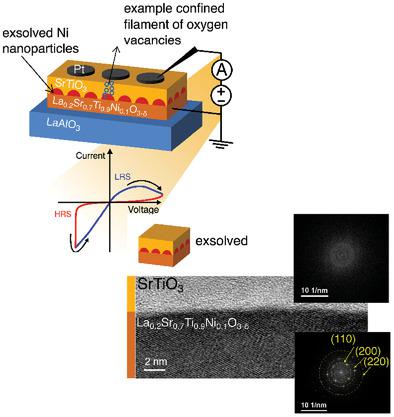Our official English website, www.x-mol.net, welcomes your
feedback! (Note: you will need to create a separate account there.)
Toward Controlling Filament Size and Location for Resistive Switches via Nanoparticle Exsolution at Oxide Interfaces.
Small ( IF 13.0 ) Pub Date : 2020-09-17 , DOI: 10.1002/smll.202003224 Jonathan Spring 1, 2 , Eva Sediva 1, 2 , Zachary D Hood 1 , Juan Carlos Gonzalez-Rosillo 1 , Willis O'Leary 1 , Kun Joong Kim 1 , Alfonso J Carrillo 1 , Jennifer L M Rupp 1, 2, 3
Small ( IF 13.0 ) Pub Date : 2020-09-17 , DOI: 10.1002/smll.202003224 Jonathan Spring 1, 2 , Eva Sediva 1, 2 , Zachary D Hood 1 , Juan Carlos Gonzalez-Rosillo 1 , Willis O'Leary 1 , Kun Joong Kim 1 , Alfonso J Carrillo 1 , Jennifer L M Rupp 1, 2, 3
Affiliation

|
Memristive devices are among the most prominent candidates for future computer memory storage and neuromorphic computing. Though promising, the major hurdle for their industrial fabrication is their device‐to‐device and cycle‐to‐cycle variability. These occur due to the random nature of nanoionic conductive filaments, whose rupture and formation govern device operation. Changes in filament location, shape, and chemical composition cause cycle‐to‐cycle variability. This challenge is tackled by spatially confining conductive filaments with Ni nanoparticles. Ni nanoparticles are integrated on the bottom La0.2Sr0.7Ti0.9Ni0.1O3−δ electrode by an exsolution method, in which, at high temperatures under reducing conditions, Ni cations migrate to the perovskite surface, generating metallic nanoparticles. This fabrication method offers fine control over particle size and density and ensures strong particle anchorage in the bottom electrode, preventing movement and agglomeration. In devices based on amorphous SrTiO3, it is demonstrated that as the exsolved Ni nanoparticle diameter increases up to ≈50 nm, the ratio between the ON and OFF resistance states increases from single units to 180 and the variability of the low resistance state reaches values below 5%. Exsolution is applied for the first time to engineer solid–solid interfaces extending its realm of application to electronic devices.
中文翻译:

通过在氧化物界面处的纳米颗粒萃取来控制电阻开关的灯丝尺寸和位置。
忆阻设备是未来计算机内存存储和神经形态计算的最主要候选对象。尽管前景看好,但其工业制造的主要障碍在于器件之间的差异和周期之间的差异。这些是由于纳米离子导电丝的随机性而发生的,纳米丝导电丝的断裂和形成决定了器件的运行。灯丝位置,形状和化学成分的变化会导致周期变化。通过用镍纳米粒子在空间上限制导电丝解决了这一挑战。Ni纳米颗粒整合在底部La 0.2 Sr 0.7 Ti 0.9 Ni 0.1 O 3− δ上电极通过溶出法,其中在还原条件下的高温下,Ni阳离子迁移到钙钛矿表面,生成金属纳米粒子。这种制造方法可对粒径和密度进行精细控制,并确保在底部电极中牢固地固定颗粒,从而防止移动和结块。在基于无定形的SrTiO装置3,它被证明作为出溶镍纳米颗粒直径增大到≈ 50nm时,从单个单元的ON和OFF电阻状态增大之间至180和低电阻状态达到值的可变性的比率低于5%。Exsolution首次用于工程实体接口,将其应用领域扩展到电子设备。
更新日期:2020-10-16
中文翻译:

通过在氧化物界面处的纳米颗粒萃取来控制电阻开关的灯丝尺寸和位置。
忆阻设备是未来计算机内存存储和神经形态计算的最主要候选对象。尽管前景看好,但其工业制造的主要障碍在于器件之间的差异和周期之间的差异。这些是由于纳米离子导电丝的随机性而发生的,纳米丝导电丝的断裂和形成决定了器件的运行。灯丝位置,形状和化学成分的变化会导致周期变化。通过用镍纳米粒子在空间上限制导电丝解决了这一挑战。Ni纳米颗粒整合在底部La 0.2 Sr 0.7 Ti 0.9 Ni 0.1 O 3− δ上电极通过溶出法,其中在还原条件下的高温下,Ni阳离子迁移到钙钛矿表面,生成金属纳米粒子。这种制造方法可对粒径和密度进行精细控制,并确保在底部电极中牢固地固定颗粒,从而防止移动和结块。在基于无定形的SrTiO装置3,它被证明作为出溶镍纳米颗粒直径增大到≈ 50nm时,从单个单元的ON和OFF电阻状态增大之间至180和低电阻状态达到值的可变性的比率低于5%。Exsolution首次用于工程实体接口,将其应用领域扩展到电子设备。











































 京公网安备 11010802027423号
京公网安备 11010802027423号